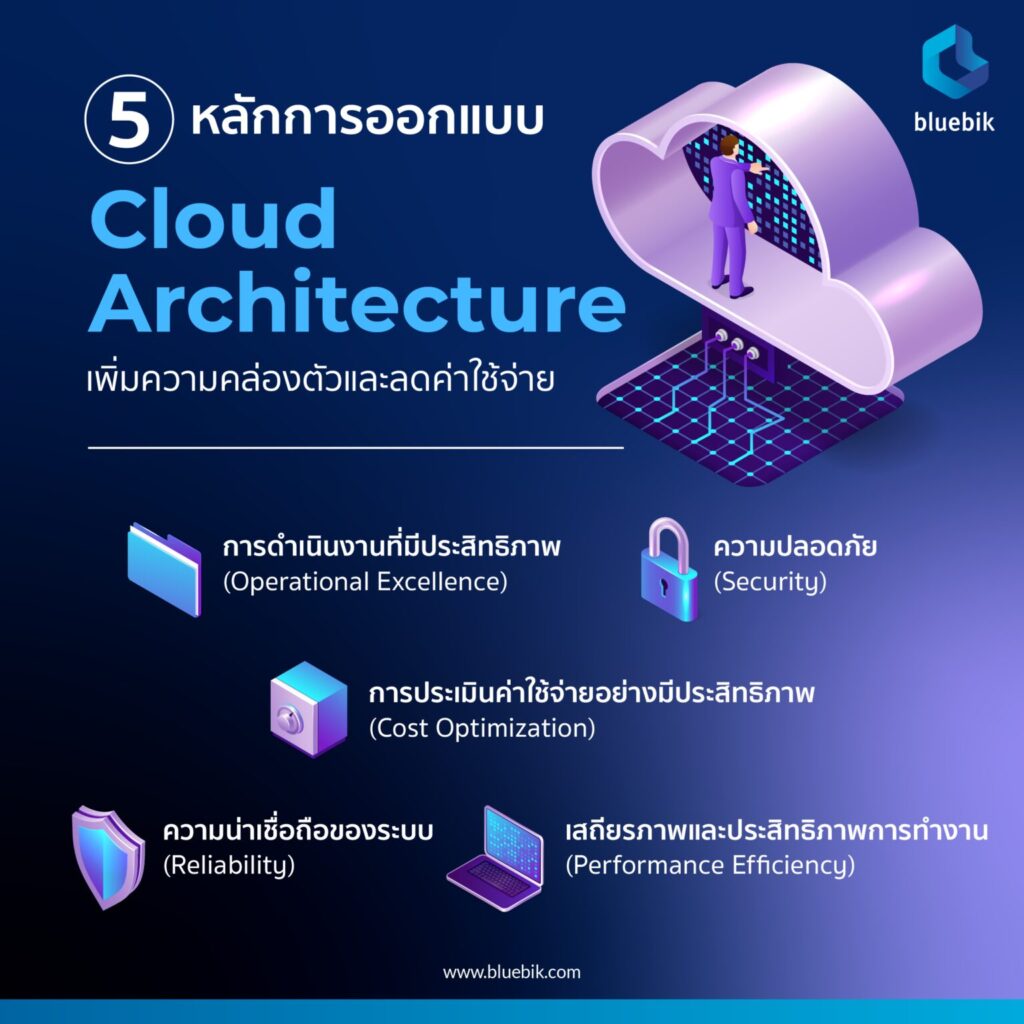บริษัท บลูบิค กรุ๊ป จำกัด (มหาชน) หรือ BBIK ที่ปรึกษาชั้นนำผู้ให้บริการด้านดิจิทัลทรานส์ฟอร์เมชัน แบบครบวงจร แนะองค์กรยกระดับเทคโนโลยี Cloud Computing ด้วยการออกแบบ ‘Cloud Architecture’ หรือสถาปัตยกรรมคลาวด์ 5 ประการ ครอบคลุมตั้งแต่การดำเนินงาน ความปลอดภัย ค่าใช้จ่าย ความน่าเชื่อถือ และความเสถียรของระบบ ซึ่งหลักการดังกล่าวจะทำให้การบริหารจัดการระบบเซิร์ฟเวอร์ (Server) ขององค์กรมีความยืดหยุ่นและมีประสิทธิภาพเพิ่มมากขึ้น อีกทั้งยังช่วยลดภาระค่าใช้จ่ายที่ไม่จำเป็น และรองรับการทำงานงานรูปแบบใหม่ๆ ที่จะเกิดขึ้นในอนาคต เพื่อปูทางสู่การเติบโตอย่างมั่นคงในระยะยาวให้องค์กร
นายพิพัฒน์ ประภาพรรณพงศ์ ผู้อำนวยการและหัวหน้าทีม Big Data and Advanced Analytics บริษัท บลูบิค กรุ๊ป จำกัด (มหาชน) หรือ BBIK กล่าวว่า ปัจจุบันระบบ Cloud Computing กำลังได้รับความนิยมมากขึ้นเรื่อย ๆ สอดรับกับผลการสำรวจของ Gartner ภายใต้หัวข้อ Cloud Shift ที่ระบุว่า ในปี 2568 การใช้จ่ายมากกว่าครึ่งด้านไอทีขององค์กรจะเกี่ยวข้องกับระบบ Cloud และมีหลายเทคโนโลยีหลักที่จะย้ายไปใช้บริการระบบคลาวด์มากขึ้น เช่น ซอฟต์แวร์ แอปพลิเคชัน และระบบโครงสร้างพื้นฐานต่าง ๆ เป็นต้น
จากกระแสดังกล่าวทำให้มีการคาดการณ์ว่า ระบบคลาวด์จะเป็นอีกเทรนด์สำคัญในโลกธุรกิจแห่งอนาคต ที่เข้ามารองรับการใช้งานขององค์กรทุกขนาด และสามารถรองรับระบบการทำงานในรูปแบบใหม่ เช่น Work from Anywhere – Any Time
นอกจากนี้ ระบบคลาวด์ยังช่วยให้การบริหารค่าใช้จ่ายขององค์กรมีประสิทธิภาพมากขึ้น เช่น ลดการลงทุนด้านเซิร์ฟเวอร์แบบ On-Premises และค่าใช้จ่ายในการพัฒนาระบบเอง และยังมีระบบการชำระเงินแบบใช้ก่อนจ่ายทีหลัง และระบบจ่ายตามการใช้งานจริง ที่ช่วยลดภาระค่าใช้จ่ายให้กับองค์กร อีกทั้งผู้ให้บริการระบบคลาวด์หลายราย มีการพัฒนาแอปพลิเคชันและแพลตฟอร์มใหม่ ๆ อย่างต่อเนื่อง เพื่อตอบโจทย์การใช้งานที่หลากหลายรูปแบบมากขึ้น
3 รูปแบบการประยุกต์ใช้ Cloud Computing
1. Infrastructure-as-a-Service หรือ IaaS
การให้บริการโครงสร้างพื้นฐานและระบบจัดเก็บข้อมูล หรือทำหน้าที่แทนเซิร์ฟเวอร์
2. Platform-as-a-Service หรือ PasS
การให้บริการด้านแพลตฟอร์มสำหรับซอฟต์แวร์ เช่น เว็บแอปพลิเคชัน (Web Application) ระบบประมวลผลกลางขององค์กรขนาดใหญ่ (Database Server) หรือระบบ API ที่มีการรักษาความปลอดภัยสูง
3. Software-as-a-Service หรือ SaaS
การให้บริการซอฟต์แวร์และแอปพลิเคชัน โดยส่วนใหญ่จะคิดค่าบริการตามการใช้งาน โดยทั่วไปแล้ว Cloud Computing มีพื้นฐานการออกแบบด้านสถาปัตยกรรม ที่ไม่ต่างจากระบบโครงสร้างพื้นฐานแบบ On-Premises ที่มีระบบคอมพิวเตอร์และเครือข่ายเป็นของตนเอง เพียงแต่อุปกรณ์หรือเซิร์ฟเวอร์ของระบบคลาวด์นั้น จะอยู่ภายใต้การดูแลของผู้ให้บริการแทน ซึ่งสามารถใช้งานผ่านระบบต่าง ๆ ได้
ตัวอย่างเช่น หน้าเว็บไซต์ (Portal) หรือ ด้วยคำสั่ง Command-Line Interface (CLI) ผ่าน Console โดยผู้ใช้งานสามารถเข้าถึงบริการและระบบต่าง ๆ ได้ง่าย ด้วยการเลือกแพ็กเกจและตั้งค่าใช้งาน จากนั้นระบบจะบริหารจัดการให้เอง และสามารถยกเลิกการใช้งานได้ตามต้องการ แต่การออกแบบ Cloud Architecture ให้เหมาะสมกับการใช้งานจริงของแต่ละองค์กรที่มีรูปแบบธุรกิจ และกระบวนการทำงานที่แตกต่างกันนั้น จำเป็นต้องอาศัยความรู้ความเชี่ยวชาญทั้งด้านธุรกิจและเทคโนโลยี เพื่อให้เกิดประสิทธิภาพสูงสุดในการใช้งาน

5 หลักการออกแบบ Cloud Architecture เพิ่มความคล่องตัวและลดค่าใช้จ่าย
‘บลูบิค (Bluebik)’ เปิดเผยถึงหลักการออกแบบ Cloud Architecture หรือ สถาปัตยกรรมคลาวด์ ตามแนวทางปฏิบัติงานที่ดี หรือ Best Practice ของบริษัทฯ เพื่อให้มั่นใจว่าระบบที่ออกแบบนั้นสามารถใช้งานได้อย่างยั่งยืน ตอบโจทย์การใช้งานจริงและพร้อมสำหรับการปรับเปลี่ยนอยู่เสมอ โดยหลักการออกแบบแบ่งออกเป็น 5 ประการ ดังนี้
1. หลักการออกแบบด้านการดำเนินงานที่มีประสิทธิภาพ (Operational Excellence)
มุ่งเน้นการออกแบบให้ง่ายต่อการตรวจสอบ การพัฒนาระบบ และสามารถปรับเปลี่ยนได้ตามความต้องการและสถานการณ์ของภาคธุรกิจ
2. หลักการออกแบบด้านความปลอดภัย (Security)
จะต้องป้องกันตั้งแต่การแลกเปลี่ยนข้อมูล การเชื่อมต่อ และการจัดเก็บข้อมูล ด้วยการเข้ารหัสไว้ทั้งหมดผ่านกุญแจ (Encryption Key) รวมถึงการออกแบบจะต้องง่ายต่อการตรวจสอบความปลอดภัย และกำหนดสิทธิ์การใช้งานให้ครอบคลุม และเจาะจงมากพอในแต่ละส่วนงาน ซึ่งการออกแบบด้านความปลอดภัยนี้ เป็นไปตามหลักปฏิบัติของกฎหมายคุ้มครองข้อมูลส่วนบุคคล (PDPA)
3. หลักการออกแบบด้านค่าใช้จ่ายที่มีประสิทธิภาพ (Cost Optimization)
มุ่งเน้นเรื่องการตรวจสอบและประมาณการค่าใช้จ่ายในอนาคตได้ง่าย สามารถลดค่าใช้จ่ายด้วยการลดขนาดเครื่องมือให้สอดรับกับการใช้งานจริง
4. หลักการออกแบบด้านความน่าเชื่อถือของระบบ (Reliability)
ให้ความสำคัญในการทำ Backup และ Restore รวมถึงการทำสำเนาข้อมูลจัดเก็บไว้ในหลายแหล่ง เพื่อให้ระบบสามารถทำงานได้ต่อเนื่องแม้เกิดปัญหา และยังสามารถรองรับการใช้งานที่มากขึ้น หรือลดลงในระยะยาว
5. หลักการออกแบบด้านเสถียรภาพและประสิทธิภาพในการทำงาน (Performance Efficiency)
เน้นการออกแบบให้ระบบสามารถทำการพัฒนาและทดสอบ ได้เหมือนกับการใช้งานจริงบน Production ดังนั้นการทดลองสิ่งใหม่ ๆ จึงทำได้ง่ายและสามารถตรวจสอบผลกระทบได้ ก่อนนำไปใช้งานร่วมกับระบบอื่น ๆ ลดข้อผิดพลาด และความเสียหายที่อาจเกิดขึ้น
นอกจาก กระบวนการออกแบบ Cloud Architecture แล้ว องค์กรที่ต้องการใช้บริการระบบคลาวด์จำเป็นต้องมีการวางแผนงานด้านอื่น ๆ ก่อนการออกแบบอย่างรัดกุม เช่น การวางแผนด้านบุคลากรที่จะเข้ามาดูแล พัฒนา และใช้งาน และการวางแผนด้านงบประมาณอย่างมีประสิทธิภาพ รวมถึงการพัฒนาโครงสร้างพื้นฐานของ Big Data บนระบบคลาวด์ ที่ต้องคำนึงถึงการนำข้อมูลให้ผู้ใช้งานทั้งนักวิเคราะห์ข้อมูลและนักวิทยาศาสตร์ข้อมูล ให้สามารถวิเคราะห์ข้อมูลและนำไปทำ Artificial Intelligent (AI) ด้วยตัวเอง หรือที่เรียกว่า Self-Service Analytics ได้
ดังนั้นหากต้องการให้กระบวนการทำงาน ตั้งแต่การเตรียมความพร้อมก่อนการออกแบบ และการออกแบบ Cloud Architecture ที่สามารถเชื่อมต่อกับระบบที่มีอยู่เดิม และรองรับการทำงานในรูปแบบใหม่ในอนาคต ให้เป็นไปตามเป้าวัตถุประสงค์อย่างราบรื่น จำเป็นต้องอาศัยความร่วมมือและองค์ความรู้จากหลายส่วนงาน ด้วยเหตุนี้ การเลือกใช้ที่ปรึกษาที่ให้บริการแบบครบวงจร และมีความรู้ความเข้าใจทั้งภาคธุรกิจและเทคโนโลยี จะช่วยให้กระบวนการทำงานทั้งหมดเป็นไปอย่างราบรื่น ลดความผิดพลาด และสามารถใช้งานระบบได้อย่างมีเสถียรภาพในระยะยาว
สำหรับธุรกิจที่ต้องการวางกลยุทธ์การออกแบบ Cloud Architecture เพื่อเพิ่มศักยภาพการแข่งขันและสร้างการเติบโตให้องค์กร ‘บลูบิค (Bluebik)’ มีทีมงานผู้เชี่ยวชาญด้าน Big Data & Advanced Analytics ที่สามารถให้บริการโซลูชันครบวงจร และการวิเคราะห์ข้อมูลขั้นสูง ตั้งแต่ระดับกลยุทธ์ไปจนถึงการนำไปปรับใช้ให้เหมาะสมกับองค์กร ผู้สนใจสามารถติดต่อสอบถามหรือปรึกษาได้ที่ [email protected] หรือโทรศัพท์ 02-636-7011












